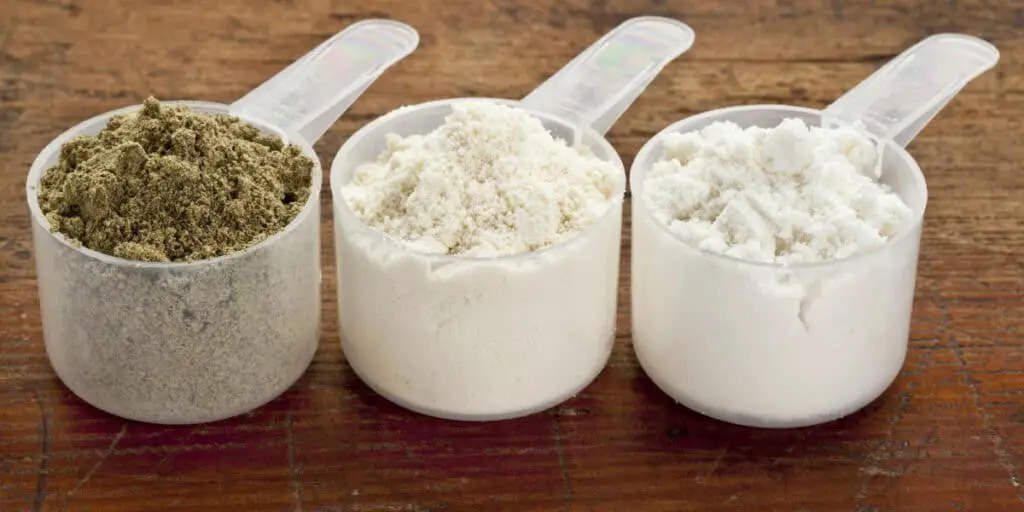If you’ve ever tried to get into shape, you’ve probably spotted that protein shakes are a staple part many fitness regimes. They provide essential nutrients that help build muscle mass, improve endurance, and boost recovery. Are they suitable post Pilates?
You should consume a healthy balance of healthy fats, carbohydrates, and protein after a Pilates class. Fortunately and conveniently, protein drinks fulfill all of these categories. A protein drink is thus a good option following Pilates.
We explore the different protein powders available to determine which is the best choice for you right after a Pilates class. This article will also touch on other food options that you may want to consider to properly fuel after Pilates.
Benefits of Protein
A healthy diet will include protein, but to make sure your body has it on hand for when it’s needed post workout then protein powder is the way to go. It’s a nutritional supplement and a staple for many who workout often.
Below are the health benefits associated with protein powder:
- Promotes muscle growth. Studies show that protein powders help to increase muscle size and length.
- Aids in recovery.
- Helps with weight management by decreasing appetite and increasing metabolism.
- Controls blood sugar. Swapping carbs for a protein drink helps improve blood sugar.
In recent years, protein powder has become widely available in a range of different flavours and it can be used in food as well as drinks.
Drinking protein right after Pilates
It’s recommended that you consume a healthy meal or snack about thirty minutes after finishing a workout. This includes a Pilates class. Protein drinks are an excellent source of protein and are attributed to several health benefits. Other protein sources include eggs, milk, and nuts.
You can get pre-mixed sports drinks or purchase a bag of powder and experiment with making your own protein shake.
The powder can also be used in food. For example, Joe Wicks famous protein pancakes for which you’ll need:
- 1 banana
- 1 scoop (30g) vanilla protein powder
- 1 egg
- 25g rolled oats
Place the ingredients into a blender and mix up to form a batter. Heat up a pan with a little oil, when hot: pour in a little batter and cook for 1 minute on each side.
These are absolutely delicious post workout, but do require a little more preparation than a shake, which you could make before you work out and take in a flash.
Choosing a Protein Powder
Protein powders generally fall into one of two categories; animal-based protein and plant-based protein. Whey and casein are both animal-based, while pea, soy, and hemp are plant-based.
Animal-based proteins come in various forms; milk-based, beef, and egg. Milk-based proteins are high quality and are the most often recommended animal-based proteins. They’re considered a complete protein because they contain all nine essential amino acids, which aren’t produced by the body and must be consumed from food.
Plant-based proteins, once thought to be far inferior to milk-based proteins, are gaining popularity. It has long since been a source of protein for vegans and vegetarians. These proteins still provide a variety of health benefits.

This article specifically discusses soy, pea, and hemp proteins, but navy bean, chickpea, and brown rice are also in the plant-based protein category.
Whey Protein
The most common form of protein supplement for workouts is Whey protein as it’s believed to be superior in terms of muscle building and recovery. Whey is a by-product of dairy, and overall, it’s absorbed quickly by the body. However, not all whey proteins are the same, and there are subtypes of whey protein.
- Concentrate. Of all the whey proteins, concentrate is the cheapest. However, it also contains high levels of lactose, which may not agree with people with sensitive stomachs. Whey concentrate protein contains about 70% to 80% of protein by weight.
- Isolate. Whey isolate is processed differently than whey concentrate as it undergoes an additional ultrafiltration process. This results in about 90% protein or more by weight and less non-protein parts like lactose, sugar, and fat. Furthermore, whey protein isolate digests quicker and easier than whey protein concentrate.
- Hydrolysate. While whey concentrate and isolate are readily available, hydrolyzed whey protein is not as common. This whey protein goes through further processing to break down the protein. Also, it’s absorbed in the gut faster and at a higher rate. Hydrolysate is the most expensive whey protein but is best for people with sensitive stomachs.
Casein Protein
As stated above, whey protein is quickly absorbed by the body, but casein protein, on the other hand, is absorbed slowly. In addition to the essential amino acids, casein also contains peptides that aid the immune and digestive systems. Casein also helps the body absorb calcium and phosphorus.
Because it’s slow absorbing, casein protein is often consumed before bed. It doesn’t mix as well as whey protein and isn’t as tasty. Some may not care for the consistency of casein. Expect to pay more for casein protein than whey protein.
Soy Protein
Soy protein is an excellent option for people who can’t digest lactose as it’s derived from soybeans. It’s often a relatively cheap protein supplement when compared to others without compromising the protein content; soy protein powders are about 90% protein by weight.
Studies suggest that soy protein may play a role in hormone balance which may lower the risks of diseases such as breast cancer, heart disease, and osteoporosis. Soy protein is also linked to improved low LDL cholesterol and triglycerides, gut health, and cardiovascular health.
Pea Protein
Pea protein is also a great source of protein. It’s plant-based, and the protein is isolated from yellow split peas yet contains all nine essential amino acids. Pea protein may be a good option for those with food sensitivity, intolerances, and allergies; it’s both lactose-free and gluten-free.
This protein is similar to whey protein in total calories and contains slightly fewer grams of protein per one ounce scoop. There are some trade-offs, however. As a dairy by-product, whey has more calcium and potassium, but pea protein provides more fiber and iron.
Hemp Protein
Hemp protein is a popular plant-based protein supplement with little processing required. It’s produced by branding pressed hemp seeds. The result is a fine powder known for its nutty taste.
Hemp not only contains all nine essential amino acids, but most often contains Omega-3 and Omega-6 fatty acids as well. You can also expect this complete protein to provide healthy fats, fiber, and minerals. Astoundingly, hemp protein is highly digestible, up to 98%.
Consuming Other Foods After Pilates
If protein drinks aren’t easily accessible right after Pilates, there are still plenty of other food options that can provide you with benefits similar to protein powders.
Above all, avoid empty calorie foods. Instead, focus on foods that are rich in protein and nutrients. You can also incorporate healthy carbohydrates, like whole grains.
Building a healthy diet around your exercise routine is highly beneficial to both your recovery and your energy levels, you don’t want a post workout slump at work thanks to a morning session and poor breakfast decisions.
Eating Before Pilates
While it’s essential that you properly refuel and replenish your body following a Pilates class, it’s equally important to properly fuel your body before class.
The best time to eat before class is one to two hours earlier. This gives your body time to digest some food while providing you the energy you need to get through the class.
If you’re short on time or simply want a small snack, you can try quick, easy foods. Some optimal pre-class snacks are berries, nuts, bananas, nut butters, cheese, yogurt, and hard-boiled eggs.
Hydration for Pilates
Adequate water intake is essential for all physical activity. And Pilates is no exception. Aim for at least eight ounces of water within thirty minutes of your Pilates class. Also, hydrate as much as needed during the workout and drink a minimum of 16 ounces in the first 30 minutes after the class.
Conclusion
Your diet plays a key role in determining how much or how well your body reaps the benefits of your Pilates class. Protein drinks are a quick and easy way to replenish and refuel your body, and there are many protein powder supplements to choose from as shown in this article. One is sure to meet your needs.
Sources
- Pilates Platinum: What to Eat Before and After Pilates to Get the Most Out of Your Workout.
- Healthline: The 7 Best Types of Protein Powder
- Men’s Health: Want to Build More Muscle in 2022? These Are the Best Whey Proteins to Buy Right Now
- Medical News Today: What Are the Benefits of Protein Powder
- SF Gate: The Advantages of Protein Supplements
- GNC: Choosing the Best Protein Powder for You
- European Journal of Public Health: Whey Protein Supplementation in Muscle Hypertrophy
- Harvard School of Public Health: Straight Talk About Soy




